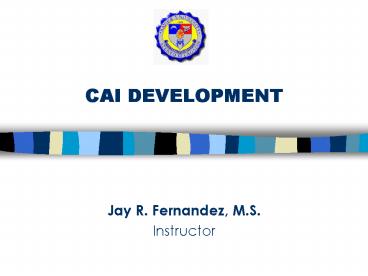CAI DEVELOPMENT - PowerPoint PPT Presentation
1 / 33
Title:
CAI DEVELOPMENT
Description:
textbooks, reference books, films, etc. procurement of hardware and software requirements ... Analysis of Philippine History. Philippine History. Pre-Spanish ... – PowerPoint PPT presentation
Number of Views:30
Avg rating:3.0/5.0
Title: CAI DEVELOPMENT
1
CAI DEVELOPMENT
- Jay R. Fernandez, M.S.
- Instructor
2
Development Model
- 1. Determine Needs and Goals
- 2. Collect Resources
- 3. Learn the Content
- 4. Generate Ideas
- 5. Design Instruction
3
Development Model
- 6. Flowchart the lesson
- 7. Storyboard displays on paper
- 8. Program the lesson
- 9. Produce Supporting materials
- 10. Evaluate and revise
4
Development Model
- 1. Determine needs and goals
- what the student should know or be able to do
- assess the characteristics and instructional
needs of intended users
5
Development Model
- 1. Determine needs and goals
- state your Goals (e.g. to teach people how to
operate the computer) - produce a chart of student characteristics
(familiarity to computers, interest in the
subject, educational level, experience in the
subject)
6
Development Model
- 2. Collect Resources
- textbooks, reference books, films, etc.
- procurement of hardware and software requirements
7
Development Model
- 2. Collect Resources
- Subject Resources
- materials relevant to the subject matter
- Instructional Design Resources
- materials relevant to the instructional
development - Media Resources
- hardware, software, operation manuals
8
Development Model
- 3. Learn the Content
- refer to expert if not familiar with subject
matter - studying resources gathered
- includes content structure and not only the
actual content
9
Development Model
- 4. Generate Ideas
- brainstorming
- conceptual design
- the more ideas you generate early in the design
process, the more likely it is that at least one
of them will be an exceptionally good one
10
Development Model
- 4. Generate Ideas
- ideas about Information to be taught
- history of computers
- parts of the computer
- types of computers
- booting-up the computes
- operating systems
11
Development Model
- 4. Generate Ideas
- ideas about how to teach the topics
- give a video about the history of the computers
- show a picture of a computer system and label
the parts - show pictures of the different classifications
of computers
12
Development Model
- 5. Design Instruction
- detailing conceptual design
- physical design
- refining ideas
13
Development Model
- Flowchart the Design
- series of diagrams describing the operations a
computer performs - visual representation of decisions and events
- shows sequence
14
Development Model
- Storyboard displays on paper
- process of preparing textual and pictorial
displays - depicts content and presentation
- draft of actual instructional messages such as
presentations, questions, feedback, directions,
prompts, pictures, and animations
15
Development Model
- Program the lesson
- translation of what you have on paper into a
series of instructions understandable to the
computer - Produce supporting materials
- student manuals, instructor manuals, technical
manuals
16
Development Model
- Test, Evaluate, Implement, Training
- debugging
- re-engineering
- evaluation intended users
- Installation
- training
17
Design in Detail
18
Design
- Elimination of Ideas
- Task and Concept Analysis
- Preliminary Lesson Description
- Evaluation and Revision of the Design
19
Design
- Elimination of Ideas
- Bases
- Characteristics of the students
- Relationship of ideas to the subject matter
- Amount of time
- Restrictions of your instructional delivery
system
20
Design
- Elimination of Ideas
Ideas Eliminated Recognizing a telephone Answering
a telephone How to use party lines History of
Telephones
Reasons for Elimination Too easy, probably
known Too easy Rarely needed Not of interest to
students
21
Design
- Task and Concept Analysis
- determine a suitable teaching sequence
- produce the necessary details of the lesson
- purpose Sequence, Structure, Content
- Task Analysis determine an efficient sequence
for teaching the content - Concept Analysis analysis of the content
22
Design
- Task and Concept Analysis
Make a Loaf of Bread
Prepare the Dough
Bake the Dough
Prepare the Pan
Prepare the Oven
Bake the Dough
Task Analysis of Bread Baking
23
Design
- Task and Concept Analysis
Philippine History
Pre-Spanish Period
Spanish Period
Magellans Discovery
Colonization
Rev.
Concept Analysis of Philippine History
24
Design
- Preliminary Lesson Description
- identifying types of learning (verbal learning,
motor skills, problem solving, rule learning,
concept learning, attitudes, and cognitive
strategies) - choosing a methodology
- identifying procedures and required skills
25
Design
- Preliminary Lesson Description
- factor decisions (e.g. feedback, question types,
directions, student control, motivation, judging,
etc.) - sequence description (focus pre-requisites,
assumptions)
26
Design
Ideas Dialing local calls Telephone
Courtesy Dialing for Information
Types of Learning Simple skill Attitude
learning Concept and Procedure Learning
27
Design
Factor Response Types Response Mode Provision
for Help
Decision Pointing at numbers to dial Pointing
with mouse Yes, by pointing at a HELP button
28
Flowchart
Indicates the beginning of the flowchart
Start
Indicates the end of the flowchart
End
Description of what happens (interaction or
feedback)
29
Flowchart
Indicates the flow with the Flowchart
Indicates decision points
Subroutine Symbol
30
Flowchart
- Level 1 Flowchart
- no branches or decision points
- tells what the application/piece is all about
31
Flowchart
- Level 2 Flowchart
- Comprehensive overview of the structure of the
lesson - includes most of the pedagogical attributes
- Contains major branches
- does not contain detailed programming decision
e.g. internal branches for data storage or
retrieval
32
Flowchart
- Level 3 Flowchart
- Put details to subroutines e.g. computational
algorithms
33
Storyboards
Storyboard Number Menu1.2
Comments If queues, go to T1 If Stacks, go to
T2 If Linked Lists, go to T3
Where do you wan to go next?
Queues
Stacks
Linked Lists
X














![Innovative Methods Computer Assisted Instruction [ CAI ] PowerPoint PPT Presentation](https://s3.amazonaws.com/images.powershow.com/6402049.th0.jpg?_=201504091211)
















